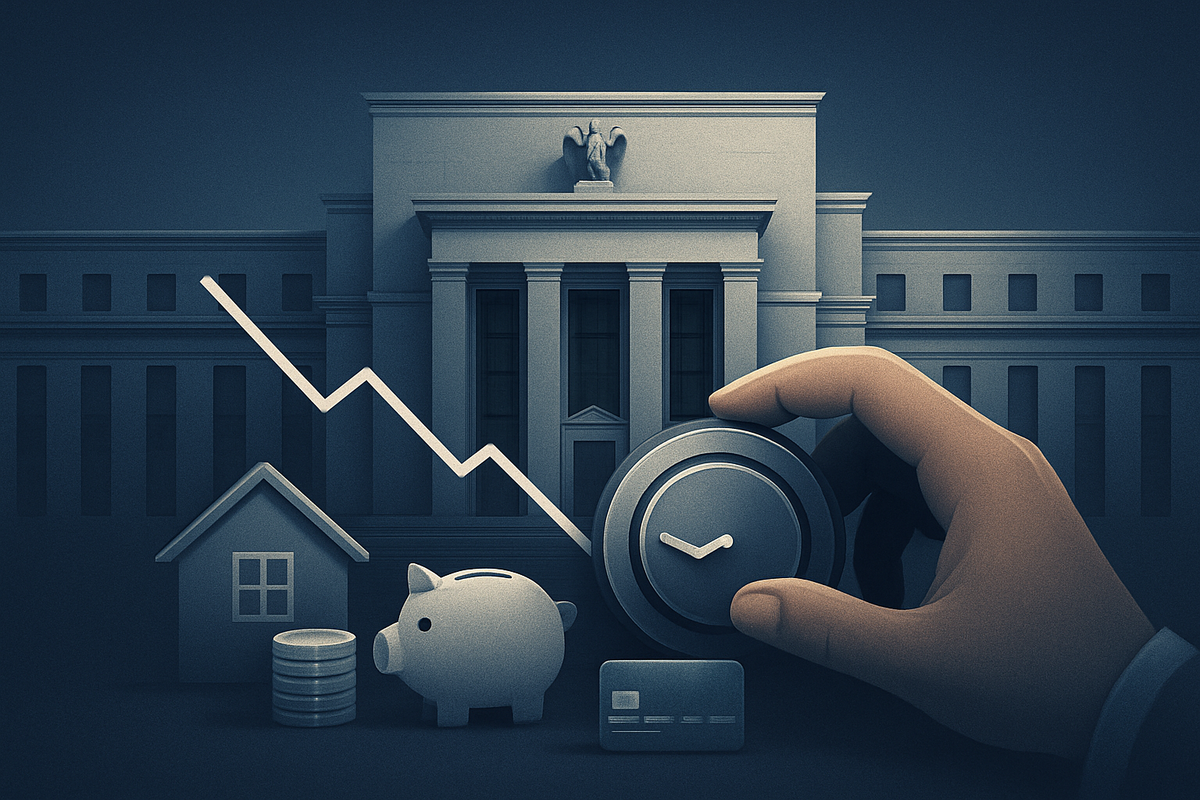
The Federal Reserve, in a closely watched move on October 29, 2025, lowered its benchmark federal funds rate by 25 basis points, bringing the new target range to 3.75% to 4%. This marks the second such reduction this year, a decision Fed officials have characterized as "insurance" against a weakening labor market and mounting economic uncertainties. While intended to bolster economic activity, this latest cut sends ripple effects through every facet of consumer finance, from mortgage rates to savings accounts and credit card costs, all while the specter of future rate changes looms large.
The central bank's action, coming amidst a backdrop of a federal government shutdown and persistent tariff impacts, underscores a pivotal shift in monetary policy. The immediate implications for households are significant, promising some relief for borrowers but posing new challenges for savers, as the Fed navigates a delicate balance between supporting employment and taming inflation.
The Fed's October Maneuver: A Closer Look at the Rationale and Market's First Take
On Wednesday, October 29, 2025, the Federal Open Market Committee (FOMC) concluded its latest meeting with a decisive vote to reduce the federal funds rate by a quarter of a percentage point. This move, which positions the rate at its lowest since 2022, follows a similar cut in September, signaling the Fed's proactive stance in addressing growing economic concerns. Fed Chair Jerome Powell articulated the decision as a necessary adjustment, aiming to bring monetary policy closer to a neutral level in light of conflicting signals from the economy.
The primary drivers behind this "insurance cut" were multifaceted. Policymakers pointed to a discernible weakening in the labor market, with job gains slowing throughout the year and a slight uptick in the unemployment rate, despite it remaining historically low. This concern for employment security seemingly outweighed the persistent, albeit nuanced, inflation that remains above the Fed's 2% target. The committee also grappled with significant economic uncertainty, exacerbated by an ongoing federal government shutdown that has delayed crucial economic data releases, forcing the Fed to operate with less than complete information. Furthermore, the lingering effects of tariffs added another layer of complexity to the economic outlook.
The decision was not without its internal disagreements. Governor Stephen Miran advocated for a more aggressive 50 basis point cut, signaling deeper concerns about economic contraction, while Kansas City Fed President Jeffrey Schmid dissented, arguing against any rate cut given the elevated inflation. This divergence highlights the challenging environment the Fed faces. In conjunction with the rate cut, the FOMC also announced its intention to conclude the reduction of its aggregate securities holdings on December 1, 2025, a move that will further influence market liquidity. Initial market reactions were mixed but generally leaning positive, with equities (NYSEARCA:SPY) seeing a modest bump as investors processed the implications of cheaper borrowing costs, while bond yields (NASDAQ: BND) saw a slight dip.
Navigating the Financial Landscape: Winners and Losers from the Rate Cut
The Federal Reserve's rate cut on October 29, 2025, immediately reshapes the financial landscape, creating clear beneficiaries and those who will face new headwinds. For consumers, the impact is a mixed bag. Mortgage rates are expected to decline, offering a welcome reprieve for prospective homebuyers and those looking to refinance existing loans. This could provide a much-needed boost to the housing market, making homeownership more accessible and reducing monthly payments for many. Similarly, interest rates on credit cards and other variable-rate loans are likely to follow suit, offering a slight reduction in borrowing costs for consumers carrying balances. However, savers will likely see their returns diminish. Interest rates on savings accounts, money market accounts, and certificates of deposit (CDs) are already low and are now poised to fall further, making it harder for individuals to grow their wealth through traditional savings vehicles.
From a corporate perspective, sectors sensitive to interest rates stand to gain. Banks (NYSE: JPM) and mortgage lenders (NYSE: WFC) might see increased demand for loans, particularly mortgages, which could boost their origination volumes. However, their net interest margins could also compress if the spread between what they pay for deposits and what they earn on loans narrows. Companies with significant debt, particularly those with variable-rate loans, will benefit from lower interest payments, freeing up capital for investment or expansion. This could include sectors like real estate investment trusts (REITs) (NYSE: VNQ) and utility companies (NYSE: XLU), which are often highly leveraged.
Conversely, companies that rely on higher interest rates for profitability or those that cater to savers might face challenges. Insurance companies (NYSE: MET) and pension funds, which often invest in fixed-income securities, could see reduced returns on their portfolios. Furthermore, while the overall market reaction was initially positive for equities, some investors might shift away from dividend-paying stocks if bond yields, even at lower rates, become relatively more attractive compared to the risk profile of certain equities. Ultimately, the rate cut aims to stimulate spending and investment, but its uneven impact will require careful financial planning from both individuals and corporations.
Wider Significance: A Preemptive Strike in an Unsettled Economy
The Federal Reserve's October 2025 rate cut is more than just a monetary adjustment; it's a significant signal about the central bank's assessment of the broader economic landscape. This "insurance cut" strategy fits into a wider trend of central banks globally taking preemptive measures to stave off deeper economic slowdowns, particularly as international trade tensions persist and geopolitical uncertainties rise. The Fed's concern for the labor market, even with inflation still above target, suggests a prioritization of employment stability, echoing lessons from past recessions where delayed action exacerbated economic pain.
Potential ripple effects extend across various sectors and international markets. Domestically, lower borrowing costs could stimulate business investment and consumer spending, potentially bolstering industries like manufacturing and retail. However, if the underlying economic weakness is more profound than anticipated, the impact might be limited. Globally, a weaker U.S. dollar, a common outcome of rate cuts, could make American exports more competitive, benefiting multinational corporations. Conversely, it could also lead to capital outflows from emerging markets as investors seek higher returns elsewhere, though the current global environment makes such shifts complex.
Regulatory and policy implications are also noteworthy. The Fed's decision to conclude its balance sheet reduction by December 1, 2025, signifies a shift away from quantitative tightening, moving towards a more accommodative stance. This could inject more liquidity into the financial system, potentially supporting asset prices. Historically, "insurance cuts" have often been deployed during periods of mid-cycle slowdowns or as a response to external shocks, such as the late 1990s or the mid-2000s. While these cuts sometimes successfully extended economic expansions, their effectiveness hinges on the true nature and severity of the underlying economic challenges. The current situation, with persistent inflation alongside labor market concerns and geopolitical tensions, presents a unique and complex challenge for policymakers.
What Comes Next: Navigating the Path Ahead
The Federal Reserve's recent interest rate cut sets the stage for a period of careful observation and potential strategic adjustments across the financial markets. In the short term, the market will be keenly watching for signs of whether the "insurance" has paid off. Key indicators include labor market reports – specifically, whether job growth stabilizes or improves and if the unemployment rate begins to recede. Inflation data will also remain critical; if price pressures continue to ease, it could give the Fed more room for further accommodative policy. Conversely, a resurgence in inflation could force the Fed into a difficult position, potentially reversing course or pausing future cuts.
For businesses, the immediate future calls for strategic pivots. Companies with significant debt may consider refinancing to lock in lower rates, reducing their interest burden and improving cash flow. Sectors like housing and automotive, which are highly sensitive to interest rates, could see a temporary boost in demand, requiring them to adapt production and sales strategies. Technology and growth companies (NASDAQ: QQQ), which often rely on readily available and cheaper capital for expansion, might find a more favorable funding environment. However, all companies must remain agile, as the uncertainty surrounding future rate changes means that the current low-rate environment may not persist indefinitely.
Looking further ahead, several scenarios could unfold. The Fed might opt for another rate cut in early 2026 if economic data continues to show weakness, particularly in the face of ongoing geopolitical tensions or a prolonged government shutdown. Alternatively, if the economy stabilizes and inflation remains sticky, the Fed could enter a prolonged pause, holding rates steady to assess the cumulative impact of its recent actions. Market opportunities may emerge in sectors that benefit from lower borrowing costs and increased consumer spending, such as consumer discretionary (NYSE: XLY) and certain industrial stocks (NYSE: XLI). Challenges will persist for income-focused investors and financial institutions navigating compressed margins. Investors should prepare for continued volatility and prioritize diversification and a long-term perspective.
A Precarious Balance: Assessing the Market's Trajectory
The Federal Reserve's October 2025 interest rate cut represents a significant strategic maneuver in a complex economic environment. The key takeaway is the Fed's proactive, albeit cautious, approach to supporting the labor market and mitigating broader economic risks, even as inflation remains a concern. This move signals a central bank willing to use its tools to prevent a deeper downturn, acknowledging the fragility of the current economic expansion.
Moving forward, the market will be characterized by a delicate balance between the stimulating effects of lower rates and the underlying economic uncertainties that necessitated the cuts in the first place. While consumers may find some relief in lower borrowing costs for mortgages and credit, savers will need to adjust their expectations for returns. Corporations, particularly those with high debt loads, stand to benefit from reduced interest expenses, potentially leading to increased investment and growth.
The lasting impact of this rate cut will depend heavily on subsequent economic data and the Fed's future policy decisions. Investors should closely monitor employment figures, inflation reports, and any developments in global trade and government policy. The conclusion of the balance sheet reduction in December 2025 will also be a critical point, potentially influencing market liquidity. In these uncertain times, a diversified portfolio, a clear understanding of personal financial goals, and a keen eye on the evolving economic narrative will be paramount for navigating the months ahead.
This content is intended for informational purposes only and is not financial advice






